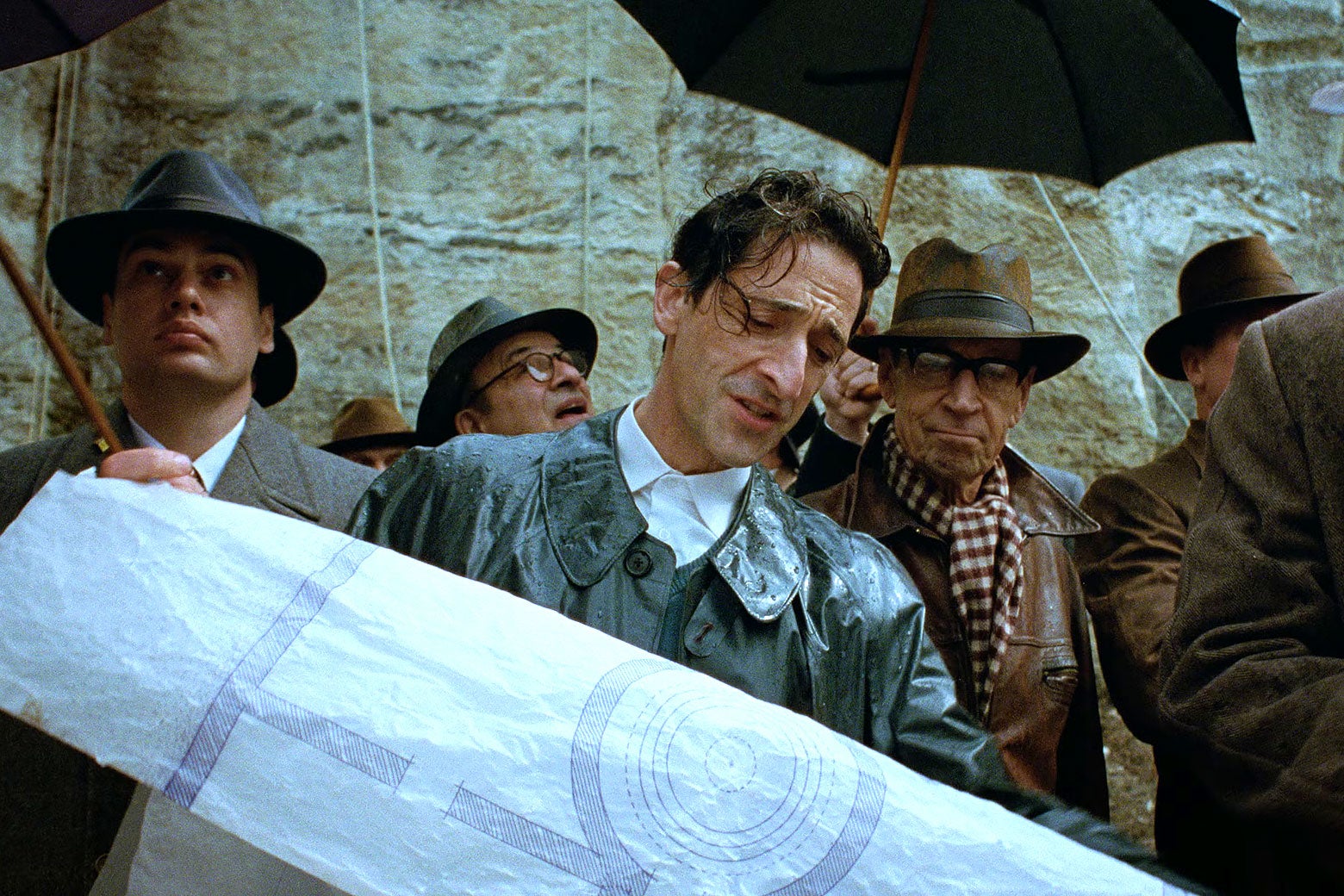
If you were on social media over the holiday weekend—and really, what better use of a holiday weekend is there—you might have noticed a controversy brewing around the use of artificial intelligence in The Brutalist, Brady Corbet’s sprawling saga about a Jewish architect who escapes the Holocaust and immigrates to the U.S. to ply his trade. If you didn’t happen to catch the initial backlash, good news: By Monday, Variety, the Hollywood Reporter, and Deadline had all picked up the story, and by this morning the internet was awash in aggregations and explainers, all blossoming two days before the Oscar nominations are announced.
The flap traced back to an article published by RedShark News on Jan. 11—an eternity ago in internet time—that actually praised the film’s “subtle and sensitive” use of artificial intelligence. Editor Dávid Jancsó detailed how the production used a tool called Respeecher to enhance “certain sounds” in Adrien Brody and Felicity Jones’ Hungarian dialogue. Jancsó, a native speaker, explained that Hungarian is “one of the most difficult languages to learn to pronounce,” and even after working with a dialogue coach, there were still lingering inaccuracies. So the actors’ lines were fed into Respeecher’s model, along with Jancsó’s own voice, to smooth things out. “We were very careful about keeping their performances,” Jancsó said. “It’s mainly just replacing letters here and there.”
This wasn’t exactly a secret—Respeecher’s name and logo are featured in The Brutalist’s end credits—nor is this an entirely new process: The tool was also used in The Brutalist’s fellow awards contenders Emilia Pérez and Maria in order to combine the actors’ voices with those of a professional singer, and a similar process was used back in 2018 on Rami Malek’s Oscar-winning performance as Freddie Mercury in Bohemian Rhapsody. And if the article had stopped there, that might have been that. But it went on to explain how the film also used generative A.I. to “conjure a series of architectural drawings and finished buildings in the style of the fictional architect” for its final sequence, which takes place at a retrospective of the title character’s career.
That passage was what set people off, especially the version aggregated by a little-known website called FeatureFirst on Jan. 18. The FeatureFirst version of the story gets details wrong, including the allegation that generative A.I. was used to “entirely create a sequence towards the end of the movie,” and alleges that “many people” have argued that the film’s use of A.I. “diminishes the craftsmanship and human creativity that audiences expect in a film centered on architecture” without providing a link to a single source. But nothing creates controversy like the word “controversy,” and soon enough, writers like New Yorker tech columnist Kyle Chayka were circulating the story. “The Brutalist used AI to make those architectural drawings at the end of the movie,” Chayka wrote on Bluesky, “that’s why they were so so bad.” My feeds filled up with people pledging to avoid the film on principle: “If the claims about the brutalist using generative ai are true then it’s being taken off my watchlist lickety split.” “My excitement for the brutalist genuinely went from 100 to 1 with this one AI revelation.”
The speed and intensity of the reaction mirrored the incident in March 2024 when it was revealed that the low-budget horror movie Late Night With the Devil had used generative A.I. for some of its designs. The film’s directors quickly moved to minimize the offense, claiming they had only used A.I. for “three still images” that they “edited further” and only appear as “brief interstitials,” but the damage seemed to have been done. A movie that few people had heard of became a movie that everyone had heard of practically overnight, and little of what they were hearing was good. After opening to good reviews and an impressive haul of nearly $3 million in its first weekend, the movie started bleeding viewers, dropping nearly 85 percent by its third week in release.
The Brutalist isn’t likely to see a similar plunge, but as the current favorite for both Best Picture and Best Actor, the scrappy little movie that has spent months being lauded for achieving epic scope on an artisanal budget has suddenly become the biggest target there is. “It’s cool that you shot on location, brought back VistaVison, blew that shit up to 70mm, got a 214 minute cut out to multiplexes and avoided an NC-17 narrowly,” wrote one Bluesky user, “but none of this matters all that much when you’re feeding your dialogue to AI software.” After the Blake Lively–Justin Baldoni lawsuit’s lesson in how Hollywood publicists can manipulate and amplify online criticism, the fact that this particular criticism is surging just as the Oscar race heats up should perhaps raise at least a bit of a brow.
Corbet rushed to explain in a statement that The Brutalist’s dialogue adjustment was “a manual process,” and that the film’s production designer, Judy Becker, “did not use AI to create or render any of the buildings,” although he did allow that “in the memorial video featured in the background of a shot, our editorial team created pictures intentionally designed to look like poor digital renderings circa 1980.” But in a 2022 interview with Filmmaker magazine, Becker said that the film’s architecture consultant had used the generative A.I. program Midjourney to “create three Brutalist buildings quite quickly,” which she planned to have redrawn by an illustrator to “create mythical buildings.” The accompanying image, credited to Midjourney, will instill a sense of déjà vu in anyone who has seen The Brutalist: A vast concrete hall with light streaming from the ceiling and a massive Christian cross in its center. It’s not precisely the same design as the chapel we see in the movie, where the cross is made of light instead of stone, but it’s certainly in the same aesthetic family.
Given that studio executives have openly fantasized about replacing living actors with computer-generated doubles, the film industry is understandably on edge about the encroachment of A.I., a circumstance some have responded to by drawing a line in the sand. But grouping disparate technologies under the umbrella of A.I. can muddy the issues rather than clarifying them. Is using machine learning to alter an actor’s voice the same thing as substituting a Midjourney prompt for a human artist, and if so, how is that distinct from the A.I.-powered technology used to de-age Robert De Niro and Al Pacino in The Irishman? Peter Jackson’s acclaimed Beatles documentary Get Back wouldn’t exist without the A.I. “demixing” tools used to separate its dialogue from the din of studio recording, and less involved versions of similar tools are regularly used to clean up audio tracks and visual effects. The use of Runway AI’s generative tools didn’t stop Everything Everywhere All at Once from becoming a cinephile favorite, or from winning Best Picture.
The companies that are pouring billions of dollars into artificial intelligence seem intent on blurring the line between generative A.I. and other uses of the technology, despite the fact that the former is both the most threatening and the most visibly flawed way to present A.I. to the general public. Most of us aren’t equipped to judge how well A.I. can analyze an MRI, but we know how many fingers are on a hand and what temperature water freezes at. Not all A.I. is created equal. You can argue that The Brutalist generating concept sketches deprived a human architect of work—although it was an architect who decided to use it, and Steven Soderbergh argues in a new interview with the Daily Beast that using ChatGPT to generate ideas is not categorically different from the way artists have always taken from those who came before them. But The Brutalist’s dialogue correction isn’t taking anyone’s job, and if the use of digital tools to smooth out imperfections in the actors’ voices makes their performances less authentic, I have bad news about virtually every modern pop song. The threat of generative A.I. especially being used to replace human labor is very real—and if it doesn’t do our jobs as well as we do, the companies pushing it will just keep at it until we get used to the inferior version. But like CGI, A.I. is, in one form or another, already in far more movies and creative products than many people realize, and if we’re going to draw a line in the sand, we better know whether we’ve already crossed it.
Get the best of movies, TV, books, music, and more.









:max_bytes(150000):strip_icc():focal(795x303:797x305)/idris-elba-sabrina-elba-milan-louis-vuitton-2-012125-d3d1edc6c4994d8c8399c98625c4d2d5.jpg)


